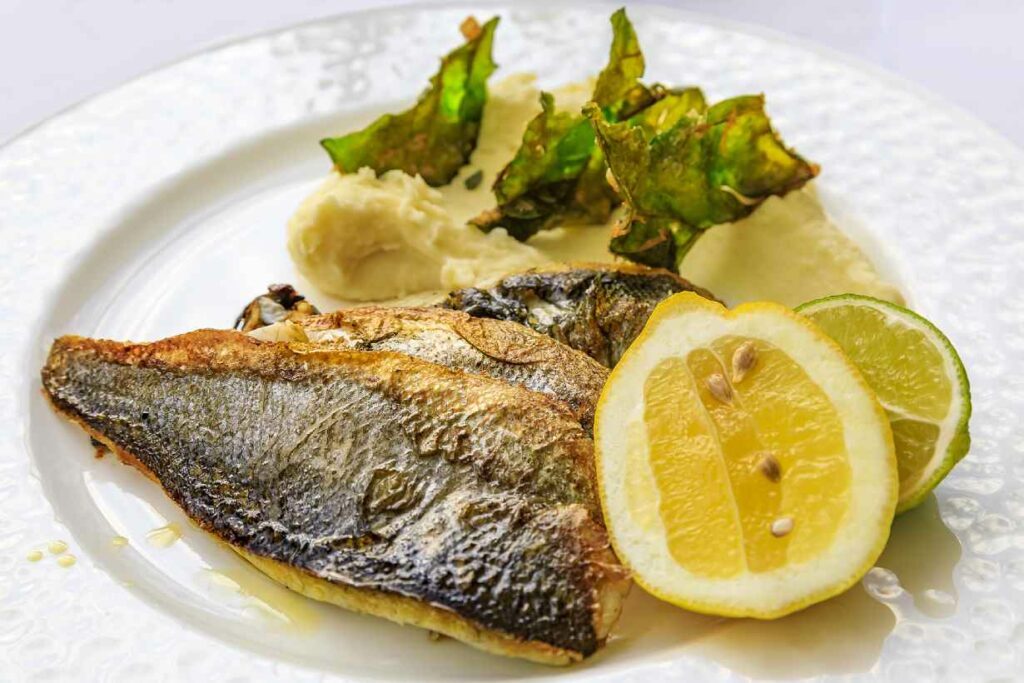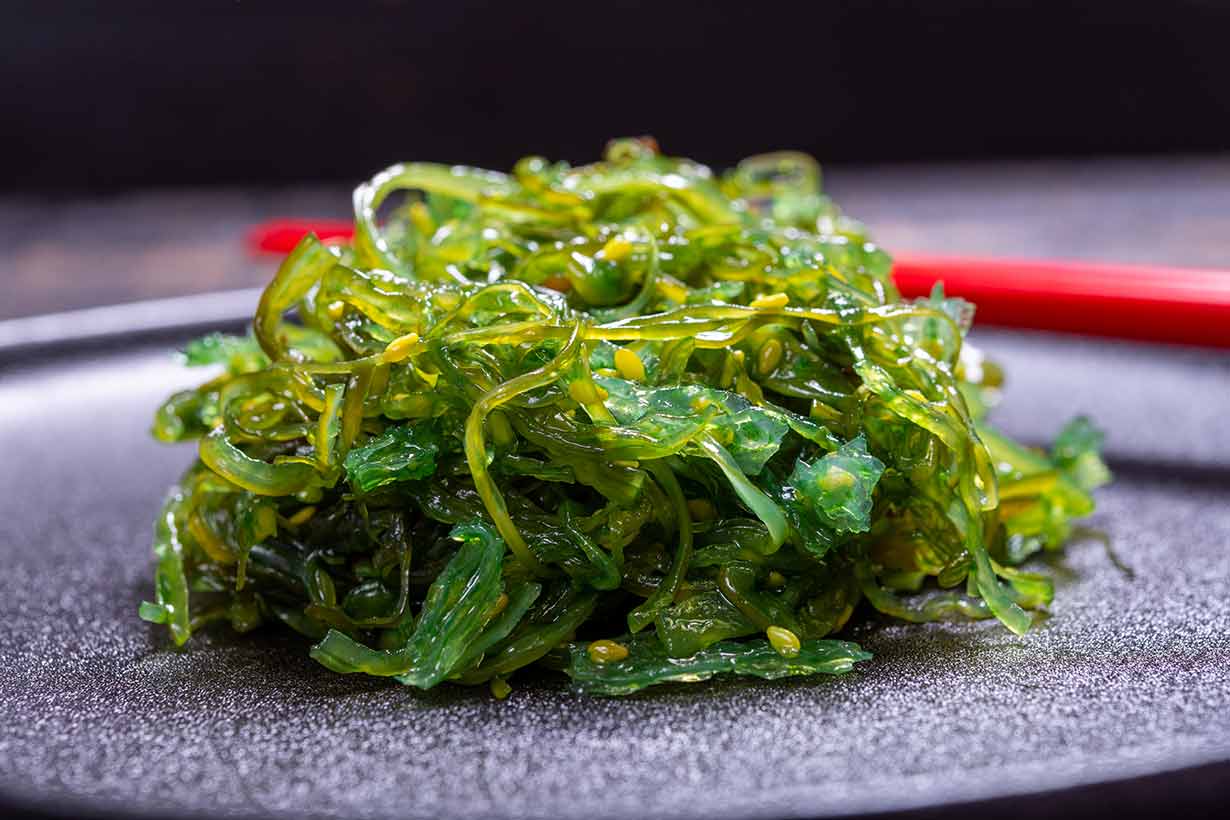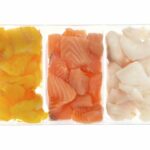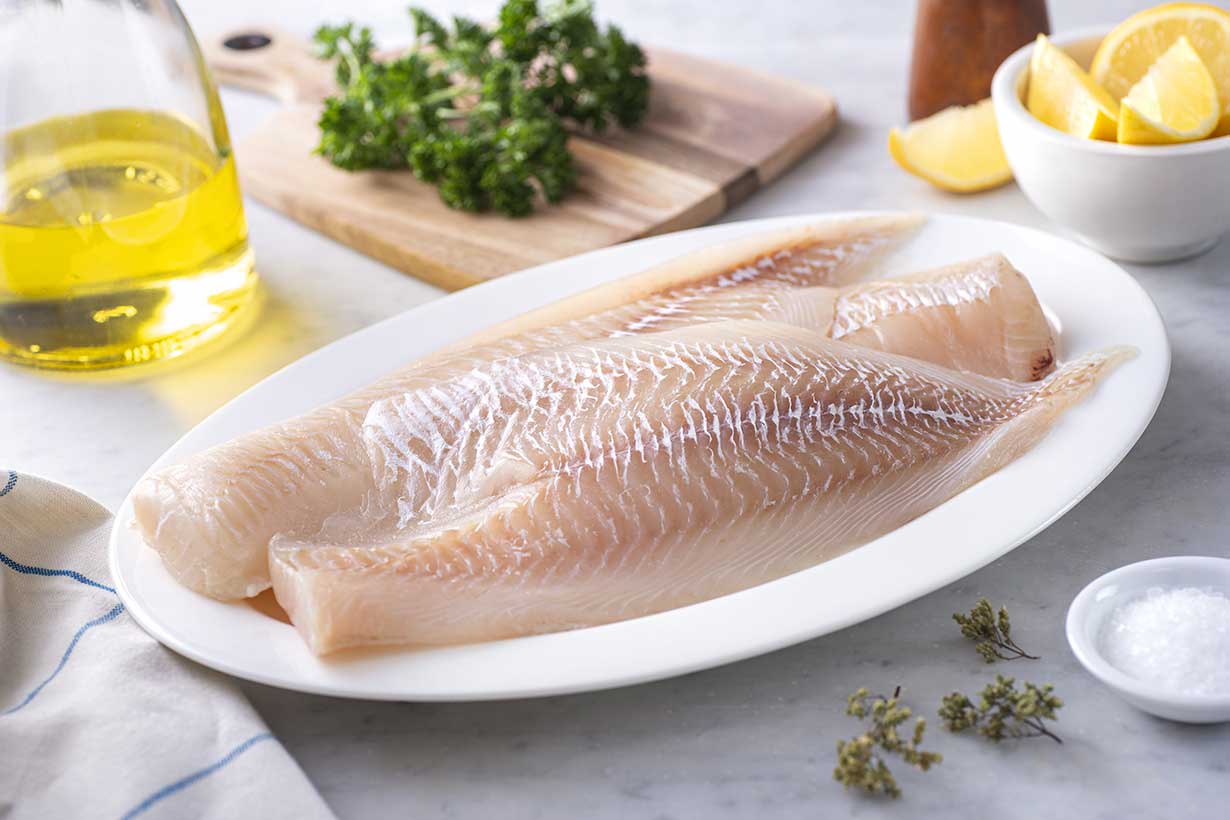Branzino is a popular fish consumed as seafood around the world.
This article looks at the nutritional properties of branzino in addition to its benefits, mercury content, and more.
Table of contents
What Is Branzino?

Branzino is a white freshwater fish that lives in the shallow waters of the Mediterranean Sea and North Atlantic Ocean along the coastline of Western Europe and North Africa (1).
The North American name of the fish is the Italian ‘Branzino,’ but in other parts of the world, it is known as ‘European Sea Bass’ (2).
Most global branzino production comes from sea cage farming (3).
Within Europe, Branzino was the first widely cultivated non-salmonid fish (1).
As of 2019, global production of branzino stood at 236,215 tonnes. The largest producers of this fish are Turkey, Greece, Egypt, and Spain (4).
Branzino has a soft, flaky texture and a slightly salty, mildly sweet flavor.
Branzino Provides a Broad Range of Nutrients
Nutritionally, branzino is a low-fat fish that provides a rich source of dietary protein. It also offers a broad range of vitamins and minerals.
Nutrition Facts
With data sourced from the USDA’s FoodData Central database, the following tables show the full nutritional values of a 101-gram cooked branzino fillet (5).
All daily values (% DV) have been calculated using USDA data and the FDA’s recommended daily values (6).
| Name | Amount | % Daily Value |
|---|---|---|
| Calories | 125 kcal | |
| Carbohydrates | 0 g | 0% DV |
| Fiber | 0 g | 0% DV |
| Sugars | 0 g | |
| Fat | 2.59 g | 3.3% DV |
| Saturated | 0.66 g | 3.3% DV |
| Monounsaturated | 0.55 g | |
| Polyunsaturated | 0.96 g | |
| Omega-3 | 0.87 g | |
| Omega-6 | 0.03 g | |
| Protein | 23.8 g | 47.6% DV |
| Cholesterol | 53 mg | 17.7% DV |
Vitamins
| Vitamin | Amount | % Daily Value |
|---|---|---|
| Folate, DFE | 6.06 mcg | 1.5% DV |
| Vitamin A, RAE | 64.6 mcg | 7.2% DV |
| Vitamin B1 (thiamin) | 0.131 mg | 10.9% DV |
| Vitamin B2 (riboflavin) | 0.151 mg | 11.6% DV |
| Vitamin B3 (niacin) | 1.92 mg | 12% DV |
| Vitamin B5 (pantothenic acid) | 0.879 mg | 17.6% DV |
| Vitamin B6 (pyridoxine) | 0.465 mg | 27.4% DV |
| Vitamin B12 (cobalamin) | 0.303 mg | 12.6% DV |
Minerals
| Mineral | Amount | % Daily Value |
|---|---|---|
| Calcium | 13.1 mg | 1% DV |
| Copper | 0.024 mg | 2.7% DV |
| Iron | 0.374 mg | 2.1% DV |
| Magnesium | 53.5 mg | 12.7% DV |
| Manganese | 0.02 mg | 0.9% DV |
| Phosphorus | 250 mg | 20% DV |
| Potassium | 331 mg | 7% DV |
| Selenium | 47.3 mcg | 86% DV |
| Sodium | 87.9 mg | 3.8% DV |
| Zinc | 0.525 mg | 4.8% DV |
Benefits of Branzino
Here are some of the main nutritional benefits of branzino fish.
High in protein
Branzino is a rich source of protein, with 23.8 grams of protein per 101-gram fillet.
Since branzino is also low in calories, this puts the fish in a select group of low-calorie, high-protein foods.
In this regard, branzino is comparable to such protein-rich foods as basa fish, chicken breast, haddock, and low-fat cheese.
Low in calories
Branzino is a low-calorie fish; a typical cooked fillet contains only 125 calories.
Getting an equivalent amount of the protein and micronutrients provided by branzino may take double this calorie content with some meat and fish products.
Significant selenium source
With 47.3 mcg of selenium per 101-gram cooked fillet, branzino provides 86% of the recommended daily value. In other words, just a fillet of branzino offers close to the recommended daily selenium intake.
Selenium is an essential mineral, meaning we must obtain it in sufficient quantities from our diet or supplementation (7).
Regarding its functions, selenium plays a vital role in DNA production and protecting against free radical-induced damage (7, 8).
Among the other minerals that branzino contains, it is also an excellent source of magnesium, phosphorus, and potassium.
Rich in B vitamins
A 101-gram fillet of branzino provides significant amounts of vitamin B6 and more than 10% of the daily value for vitamins B1, B2, B3, B5, and B12 (5, 6).
B vitamins are essential for numerous functions within the human body. These include breaking down nutrients in food, energy production, nutrient transportation, and more (9).
In addition to B vitamins, branzino is also a good source of vitamin A.
Moderate Source of Omega-3 Fatty Acids
While not quite as high as several varieties of oily fish, branzino is moderately high in omega-3 fatty acids, with 0.87 grams per 101-gram fillet.
The omega-3 fatty acids found within branzino (as with all fish) are eicosapentaenoic acid (EPA) and docosahexaenoic acid (DHA). These two omega-3 fatty acids are highly bioavailable, and their intake can vastly improve omega-3 index status (10, 11, 12).
A higher omega-3 index is associated with a lower risk of cardiovascular and all-cause mortality (13, 14).
The omega-3 index measures how much EPA and DHA are present in erythrocytes (red blood cells) as a percentage of total fatty acids.
Mercury Content
Despite most seafood being an excellent source of nutrients, several seafood products have a clear downside; high levels of mercury. Mercury is a heavy metal that, at high intake levels, is associated with neurological impairment and damage to the central nervous system (15, 16, 17, 18).
Unfortunately, some nutrient-rich fish, such as swordfish, contain high levels of mercury. For this reason, the U.S. Food and Drug Administration (FDA) and Environmental Protection Agency (EPA) recommend avoiding swordfish during pregnancy, breastfeeding, and childhood (19).
On the positive side, branzino has moderately low concentrations of mercury.
How much mercury does branzino contain?
Based on 101 samples collected by the FDA between 1991 and 2010, saltwater sea bass (branzino) contained a mean mercury concentration of 0.167 PPM (20).
This mercury content is not as low as fish like sardines (0.013 PPM) and anchovies (0.016 PPM). However, it is significantly lower than fish like albacore tuna (0.358 PPM), king mackerel (0.73 PPM), and swordfish (0.995 PPM).
Unfortunately, the FDA makes no specific recommendation for European sea bass (branzino) intake.
However, the FDA includes monkfish (0.161 PPM mercury) on its “good choices” list aimed at pregnant women and children. The recommendation for “good choices” is to eat one serving per week. Monkfish (0.161 PMM mercury) and branzino (0.167 PPM mercury) have a very similar mean mercury content (19, 20).
Fish on the FDA and EPA’s “best choices” list can be consumed at “2 to 3 servings per week.” This list includes anchovies, Atlantic mackerel, cod, haddock, herring, salmon, and sardines (19).
Sustainability Issues
Although outside the realm of nutrition, sustainability is important for some people when considering their food choices.
In this regard, branzino appears to have mixed ratings.
The Environmental Defense Fund (EDF) gives European sea bass an ‘OK’ rating, considering the fish’s historical records, its abundance, impacts on habitat, and current management (20).
However, Monterey Bay Aquarium Seafood Watch recommends branzino farmed in indoor recirculating tanks as a “best choice” for seafood (21).
In contrast, the organization also gives an “avoid” rating to branzino farmed in marine net pens (22).
Full reports are available in the references linked above for anyone wishing to know more about these sustainability issues.
How To Prepare and Cook Branzino
Branzino is typically grilled, pan-fried, or roasted in its skin and served alongside vegetables.
However, as with any fish, there are numerous ways in which it can be prepared.
A popular branzino recipe is available here that involves olive oil, lemon, red onion, cherry tomatoes, dill, and some other seasonings.
Final Thoughts
Branzino is a fish with a soft texture and delicate flavor. In addition to its popular taste characteristics, it offers a good range of nutritional benefits.
Among these, it provides significant protein and selenium content and a moderate amount of omega-3 fatty acids.
To summarize, branzino is a tasty fish with a lot of nutritional value for minimal calories.








